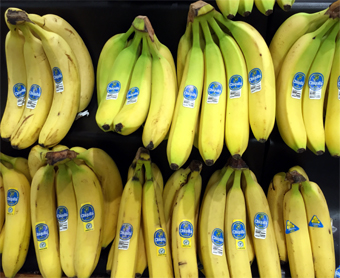
Bananas: Kings of Potassium
| published August 30, 2015 |
By Maggie Nichols Thursday Review contributor
Bananas, like many other fruits, have the advantage of being a ready-to-eat meal. There’s no fuss: no cleaning, no cooking, no refrigeration required. Just peel and eat. They can be carried around in a backpack, purse, bag or briefcase all day, or they can be stashed in a desk drawer at work or left sitting on the kitchen counter at home. Bananas have few rivals in the convenience department. Even apples, which can eaten raw at room temperature, require some modest washing, but bananas are already prepackaged and ready to go.
Bananas can be eaten or prepared a variety of ways aside from eating them raw. Bananas can be quickly and easily sliced to be added to spring or summer fruit salads, for one. Soft and pliable, bananas can be tossed into a blender and mixed with any number of ingredients to make healthy milkshakes or smoothies, and their flavor is compatible with nearly every form of fruit in mixed form. A single banana can be added to yogurt, one percent milk, low-fat ice cream, or sherbet to create thickness and volume to shakes and smoothies, allowing you to go easy on the high fat stuff like ice cream.
If you are into more serious forms of cooking (sorry folks, blender treats don’t count as “cooking”), bananas are also a time-honored element in muffins and breads. There are many hundreds of recipes out there for banana nut bread and banana-based muffins. Likewise, a simple search of the web produces a thousand recipes for banana pudding, and other desserts and treats which include bananas as a main ingredient.
Not concerned about calories or weight? Then there is always the old-fashioned banana split, for which there are dozens of variations based on region and taste.
Among the most amazing things about bananas is their potassium content, arguably their most famous health feature. According to most dietary and medical studies, a typical banana can contain as much as 400 milligrams of potassium, and potassium—for those of you who have been asleep for the last decade or so—is one of those honest-to-God miracles of the mineral and vitamin world. Among its most profound benefits is its ability to maintain healthy muscle tissue and tendon strength, and it is also linked in dozens of major medical studies to the body’s ability to maintain proper fluid levels and hydration balance. Just ask any athlete about the power of a single banana. For older people (and by “older” I mean anyone above the age of 55), bananas are a great way to avoid leg and foot cramps—a common problem brought on by low potassium levels and mild dehydration.
Bananas are also packed with vitamin C, another great miracle of the vitamin and mineral world. Vitamin C’s benefits have been widely discussed in recent years, but the short list of its strengths include eye health, cellular strength and regeneration, the absorption of other vitamins into the body (Vitamin C is a facilitator of other vitamins’ effectiveness), and the enhancement of the body’s immune system. According to some studies, people with a full complement of vitamin C in their diet may have the ability to ward off common problems like colds and flus.
Other things found in high quantities in a banana? Vitamin B-6, manganese, and fiber. A diet high in fiber, according to many studies, may lead to a substantial reduction in the risk of intestinal, colon, and other internal cancers.
Worried about weight? A single banana has only about 100 to 110 calories. Bananas are free of cholesterol and fat, and their natural sugars are more effectively managed by the body than other forms of sugar. That means that bananas are an excellent way to avoid hunger between meals at work, at school, or when travelling long distances.
Bananas are also relatively inexpensive, and because they are easily grown in several parts of the world—especially in Central and South American—they are resistant to sudden swings in prices at the grocery stores. Though some of the biggest producers of bananas are in Asia (India, China, Indonesia), the majority of U.S. bananas come from Ecuador, Costa Rica, Columbia, Guatemala, and the Philippines).
In short, the banana is not only a miracle treat, it is also one of nature’s great pre-packaged foods. The only thing to worry about: where to toss that peel.
Related Thursday Review articles:
The Health Magic of Berries; Maggie Nichols; Thursday Review; November 1, 2014.
What is a Plantain? Plantains Vs. Bananas; Michael Sigler; Thursday Review; June 26, 2014.
